Jihai Winter Solstice Tour One of the Flower Cities: Shawan Ancient Town
Because Guangzhou has a hot and humid climate, it will never freeze its hands and feet even in winter. It grows flowers spontaneously and inserts willows into shade, so it calls itself a flower city. Guangzhou is also called Yangcheng. Perhaps it is also because of climate reasons that sheep will become fat if they don't eat grass? I don't know if this is the case. Winter in the north is cold, so you can go to Guangzhou to escape the cold, also called roasting. I also followed them to Huacheng during the winter solstice to see the winterless scenery.
Although I used to go to Guangzhou for business trips, I rarely saw the scenery. That was because since it was a business trip, of course I had to be selfless. This time I came specifically to see the scenery privately, so I can stay here and watch it slowly. Stayed at a hotel with a subway station at the side entrance, and saw the dazzling light in the lobby when you entered.

The hotel's front desk clerk told us that the hotel's breakfast is open until 10:30 a.m., so you can get up late and eat to achieve the small goal of getting up late and eating more. The next morning, I followed the instructions and had a slow-style breakfast. In fact, local people have to eat morning tea until it is connected with lunch. We don't have that deep morning tea time. When we are full, we go out the side door and get off the subway. Guangzhou's subway is now very developed, and you can travel far by buying a ticket. We sat in the distance until we reached Panyu, and then we arrived at our destination Shawan Ancient Town.
Panyu has a very ancient history. The earliest urban construction should be traced back to the time when Qin Shihuang established Nanhai Prefecture in Panyu, which was in 230 BC. According to their own accounts, the town of Shawan was built in the Southern Song Dynasty, eight hundred years ago. The ancient buildings left behind should be from the late Ming and early Qing Dynasties. No matter what, since there are ancient buildings in Shawan, you can definitely see the traditional buildings of Lingnan. When arriving at Shawan Ancient Town, the first thing to do is to pass through the outer defense system. In the past, defense mainly relied on military power, but now defense mainly relies on commercial power. Every road entering the ancient town is guarded by various shops on both sides, selling various local specialties.

There are crowds at the entrance of the local snacks.

This is called "fish cake" and it looks very similar to persimmon cakes in northwest China. I guess the taste must be different.

Here, a mother is buying chicken on her back, preparing to give it to her child and her father at noon. Although the store's brand says several flavors of chicken, it's actually a white-cut chicken sprinkled with different seasonings. It's not expensive and should be delicious.

The most greedy thing is the one below, but I have no time now, otherwise the noble and humble will buy a piece to try it.

In the past, villages had to have an open space at the entrance of the village. There must be a big tree on the open space, and there must be a red bell hanging on the tree. When something happens, the village chief will pull the rope on the bell hammer to make the bell ring, and the managers of each family in the village will go under the tree to listen to the village chief's speech. The same is true for Shawan Ancient Town. The big tree on the open space at the entrance of the village is still there, but the bell on the tree is gone. The village chief now does not need to call villagers to come under the tree to listen if something happens. He can directly send messages in the village WeChat group. In this way, naughty people can be prevented from talking back; if anyone talks back in the group, the village chief can block him.
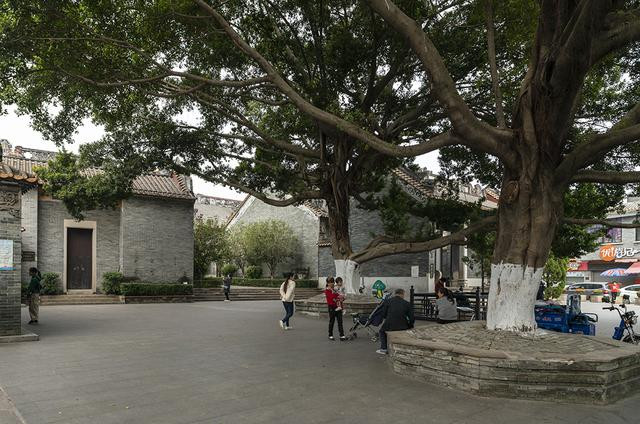
However, the villagers are still used to going to activities under the big tree at the entrance of the village. You see here are two old buddies playing games on the steps next to the big tree.
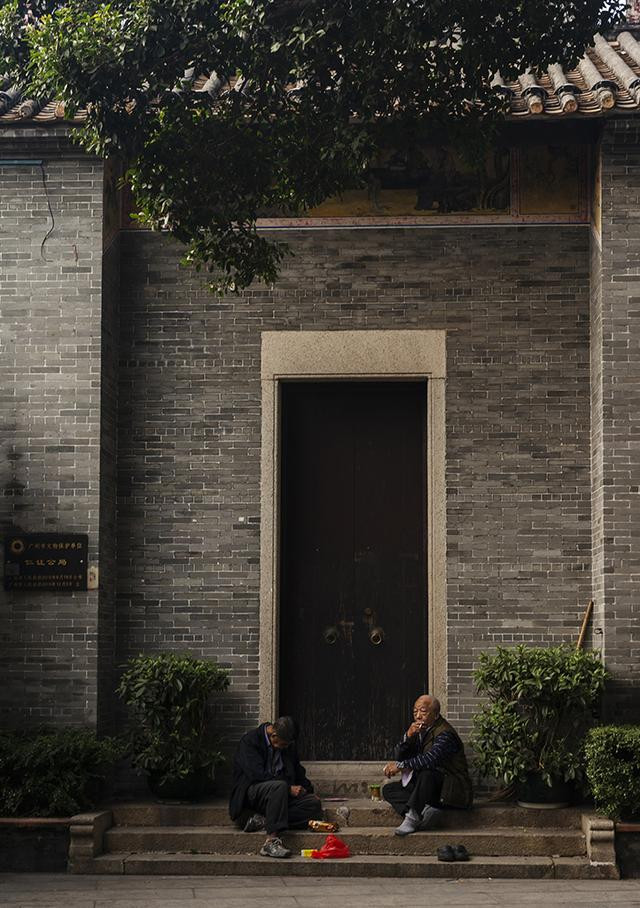
The residents took their children to play under the shadow wall at the entrance of the village. Look at this mountain-shaped shadow wall. It is in Lingnan style, with brick carvings on the main ridge on it. The ridge at the four corners is not called a raised ridge, but a rolling kill. "Kill" means a shape that becomes thinner and narrower. The roof ridge of buildings in the Qin and Han Dynasties had such a rolled-up kill end, called rolled-up kill, a very ancient architectural element.

Lingnan buildings have a wall similar to the wind and fire wall of Hui-style buildings, called the "Wuo Erqiang". In order to demonstrate Lingnan culture, the tourism authorities of Shawan Ancient Town built a model of wok ear wall at the entrance of the village.

Like the emblem type wind wall, this wok ear wall is the side gable wall of a house on a hard hilltop, but its fire protection function must be very limited because its area is much smaller than the wind wall. The main function of this wok ear wall is actually decoration, so it is decorated with flowers, brick carvings and color painting.
Look at the Shawan Guangdong Music Museum at the entrance of the village. It has a two-story building, a wok ear wall, and a hard mountain top.

There are also brick carvings and gray carvings on the main ridge, which are works in recent years and are very new.
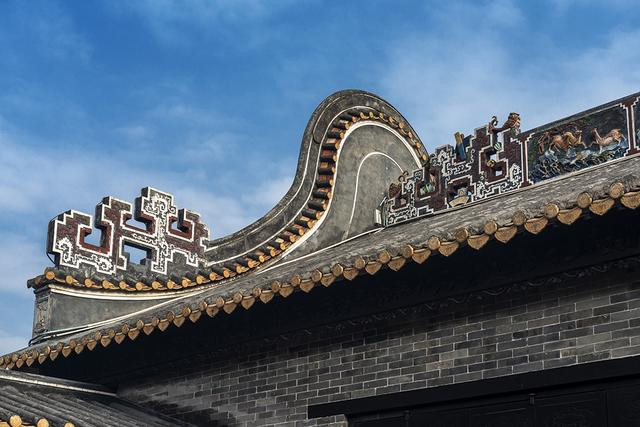
Look at the gray carving of auspicious patterns on the second floor of the courtyard inside the Guangdong Music Museum. Many railings in Lingnan buildings are made of such dark blue glaze vases.

Shawan is the most important birthplace of Guangdong music. He Liutang, the first generation of Guangdong music master, is a native of Shawan, a pipa performer and the author of "Rain Beat Planets". Guangdong music first evolved from the accompaniment of Cantonese opera, extracting the interplay, cut-off, etc. of Cantonese opera into independent tunes. Later, it gradually developed into a musical style. Like the three major accompaniment pieces of Peking Opera, Guangdong music also has three pieces: Gaohu, Yangqin and Qinqin, which is a bit like Ruan. Gaohu's position in Guangdong music is the same as Jinghu's in Peking Opera. It is also the main instrument and the core of the band. The Shawan Folk Guangdong Music Club now gathers in this Guangdong Music Hall every day to perform and communicate. This is one of the few folk music organizations that still exist in Guangdong. We sat inside and enjoyed a few of their performances. They were all Cantonese opera opera, and we couldn't understand a word of the opera, just like listening to Italian opera. But they sang really well, no less than a professional Cantonese opera group and much better than the Beijing Opera fans in Beijing parks. This Cantonese opera is like the Beijing Opera scene, but it also has different roles and is called the ten major professions. The two paragraphs we listened to were from the end of our lives, and seemed to be stories of the Red Chamber. Although it is a cappella sung by folk enthusiasts in Shawan, the line, pronunciation, and band are all very professional and beautiful.
There is also a Cantonese music master named He Shaoxia in Shawan, who is He Liutang's cousin, and his former residence is still preserved in the town. At that time, the three Shawan pipa masters, He Liutang, He Shaoxia and He Yunian, were jointly known as the Three Heroes of He's Family and were the founders of the Guangdong Music Elegance School. Pay attention to the overlapping brick carvings under the eaves of its gatehouse and are very exquisite.

Cantonese people respect the land god very much. They usually set up shrines to worship the land god as soon as they enter the door. The same is true for He Shaoxia's family.
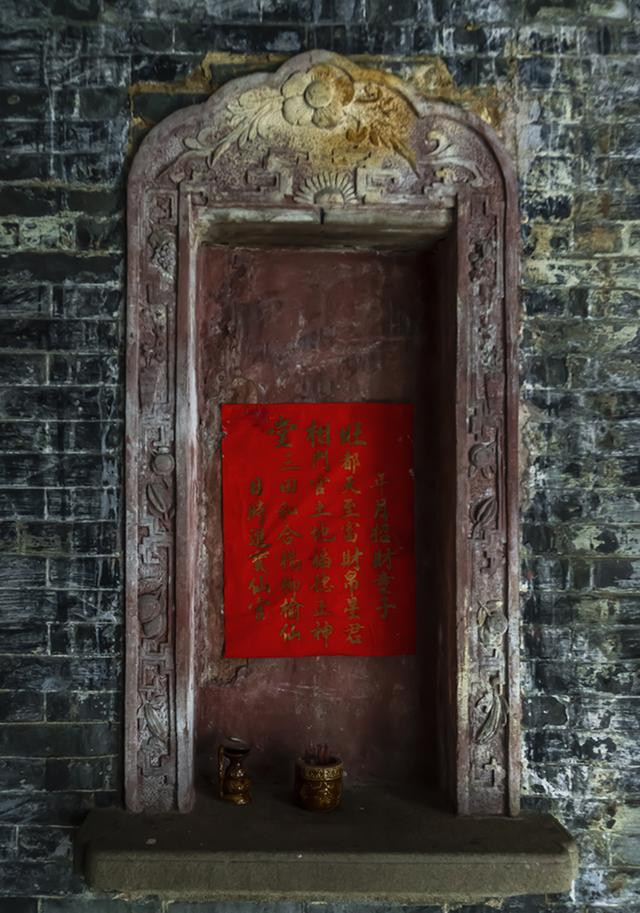
When the three heroes of Ho's family founded the Guangdong Music Group, they did not have the Guangdong Music Hall at the entrance of the village. They can be said to be the earliest Shawan Folk Music Club. At that time, the venue for their activities was a large house called the "Sanmin Hall", and the "Min" thought of tolerance.

This mansion was built during the Jiajing period of the Qing Dynasty. It is probably an old house in the town, with the oldest wok ear wall on it. The bucket-type frame roof is decorated with mosaic brick carvings under the eaves of the facade. It is very complete and may have been renovated in recent years. The gray carved plum blossoms are also very new.

The name of Sanmin Hall comes from a Sanmin tree planted in the courtyard. It is very old and dates from the late Ming and early Qing Dynasties. What is Sanmin? It looks like a peach, but it tastes extremely sour, more powerful than lemon. Generally, no one eats the Sanmin fruit. Don't look at the sour fruits on the trees, you can look at the brick carved tree pit. It's very beautiful.

He's three heroes used to rehearse and perform Cantonese music in this hall, and their descendants also performed old tunes and composed new songs here. Nowadays, Shawan musicians all go to the Guangdong Music Museum for activities, but they will only strive to inherit the singing, reading, and fighting of their predecessors, and it is no longer possible to innovate. This is true not only for Cantonese music and Cantonese opera, but also for all Chinese operas. Even for a national quintessence like Peking Opera, there are few new operas. Only the old people cry, but not the new people laugh. If traditional culture only indulges in nostalgia and lacks innovation, it will definitely gradually enter a situation where it can only rely on archaeology to see the light of day.

As the birthplace of Guangdong music, it is also a memorial hall, with professional commentators giving us a few treasures.

In addition to the wok ear wall, there are more common "herringbone walls" in the hard hilltop houses built in Lingnan. The side gable walls on the hard mountain tops in the north fall from the roof, while the wok ear walls and herringbone walls in Lingnan are higher than the roof. Look at this herringbone wall.

There are actually lion decorations on the ridge! The one below is also a colorful lion.

Follow the small street into the ancient town. Suddenly, he realized that the wall next to him was covered with something. On closer inspection, it seemed to be shells or something. It turns out that this is the legendary "oyster shell wall". Oysters in Guangdong are what people in Dalian call sea turtles, and what people in Beijing call oysters. With so many oyster shells used to build walls, the family must have eaten a lot of raw oysters, right? I guess they bought oyster shells specially for building walls. They said that such a house is warm in winter and cool in summer, just like oysters living in it.

In addition to oyster shells, there is also a special kind of brick called "Water Mill Green Brick". The dark wall on the right hand of the sign in the picture below is the Water Mill Green Brick Wall. It is said that when building this kind of wall, green bricks must be ground to the same size. The mortar used for bricklaying is made of ground clams shells, glutinous rice flour and rock sugar. After hardening, it is very dense and hard. Then smooth the outside of the wall and wax it. A house built with such walls can live for thousands of years without collapsing. Of course, it doesn't count if the roof collapses.

There is a teahouse at the end of the path. On the opposite wall is a picture of a little boy jumping to climb someone's window. This is a recreational activity for modern villagers.

The villagers in the past are all old now and can only sit under the window and tell passers-by about their future.

At the end of the path, there was another big tree and an open space next to the teahouse, surrounded by old houses. This may be a small conference room in the village in the past.

Look at the roof below, this should be an old house.

This must be the house of a large family. In addition to the tall second-story house with wok ear walls, there is also a pair of lanterns at the door. The lanterns in Lingnan are completely different in shape from the lanterns in the north, and they have auspicious paintings on them. They should also have the name of the house. The "Shawan Fish Lantern" on this pair of lanterns is not the name of the lantern, but the fish lantern display in the hall. There is an annual fish-shaped lantern making competition in Shawan.
The herring-walled mansion I just saw is a memorial hall, the birthplace of Chinese polymer chemist He Binglin. Mr. He Binglin is a professor at Nankai, an academician of China Science and Technology, the founder of China's ion exchange resins, and one of the heroes of two bombs and one satellite. He has realized the use of ion exchange resins to extract uranium materials from uranium ore.

This is an ancestral hall, which belongs to the small ancestral hall. It is called a hall, a well and two corridors. It is a three-bay main hall with corridors on both sides and a patio in the middle. Stand in the patio and look at the main hall.

There is an eaves corridor in front of the main hall, and most of Lingnan use black lacquer wooden pillars and separate doors, giving people a solemn and majestic feeling.

The ancient town is full of narrow roads, and only one person can pass through like this. I was surprised. How did his refrigerator move in? But there are old houses in the narrow road.

There are also old houses in this small narrow road.

In the ancient streets of the ancient town, new families in the old houses all open shops.
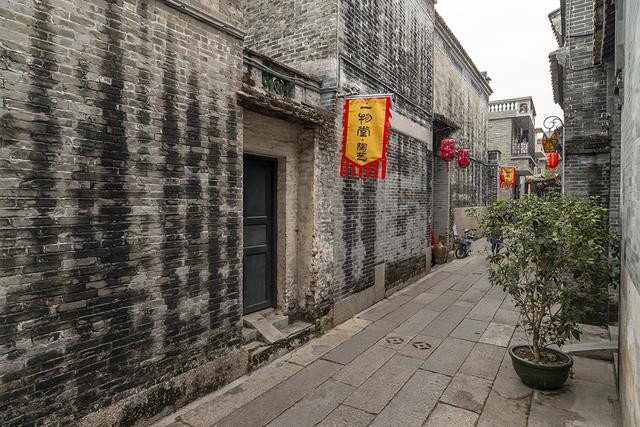
Ancient alley. Look at the dark and oily wall. It must be Shawan Agui who often sits there leaning against the wall to catch lice.

There is a new store on the ancient street. Although it is called Gaolaozhuang, I don't think it has any real relationship with Pig Bajie. It sells sugar water. In addition to sugar and water, there are also other impurities mixed in the sugar water. The noodle under the "" behind sells Zhusheng noodles. Zhusheng noodles are actually noodles made with bamboo poles instead of wooden rolling pins. This is the noodle rolling method used by Cantonese people. Nowadays, all the noodles in urban Guangzhou are machine-rolled sections. Where are there any hand-rolled noodles? The noodle itself is not the key, the key is what is in the noodle soup, right? The best noodles I have ever eaten are the noodles I ate in Changsha in the 1970s, shredded pork noodles, pork liver noodles, eel noodles, etc. That noodles are very special, but now they are gone, and I can't eat them even if I go to Changsha.

Look at the taste of Shawan on this little underworld. It is called "Ginger Buried Milk". I came forward and asked "What dish does Grandma Jiang make?" People said that Grandma Jiang makes a nutritious drink. Mash the ginger into powder in a garlic jar, then put a spoonful of the ginger powder with ginger juice in a bowl, add hot milk to bury it, and let it be drunk for a while. You can add sugar or salt, depending on the guest's personality. It is said that drinking in winter will not hurt the stomach, and drinking in summer will not hurt the liver. If you don't drink it, you will be sad.

There is only one big restaurant in the town. If you look at this window, you will feel that the food served inside is not bad.
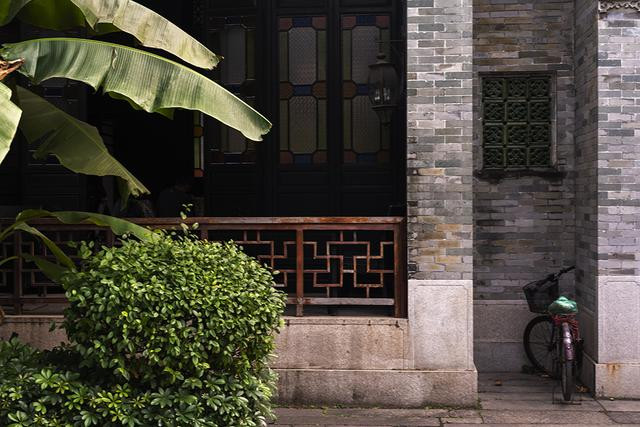
Most of these shops sell food and drink, but you can occasionally see such a very romantic shop below. This is the cheongsam worn by women in Guangdong, Hong Kong and Macao. No matter whether they are beautiful or not, women wearing such cheongsam will be full of customs when walking on the road.

Although you may think that such a romantic shop is quite good, in fact, there is a very unromantic Guanyin Temple next door. There is not much incense inside, but there are villagers who have placed Guanyin statues and incense burners outside the door. There is fragrance in the censer but no fire, and the wine cup is empty. It seems that everyone in the village is living well and has nothing to ask for.

There is not a lot of incense in Guanyin Temple, but there is a very decent Yuxu Palace over there.

I looked at the sign in the door. It was dedicated to Xuantian God. The full name of Xuantian God is the North Pole Zhenwu Xuantian Emperor, who is the god of the North. There are Zhenwu temples in many places in China, where this northern god is dedicated to Wudang Mountain.

In front of Yuxu Palace is a large square called Tianjie, paved with bluestone slabs. There are two pairs of stone pillars standing on the square. Could this be a lost archway? I stepped forward and saw that there were still words on it. It turned out that this was the results of the Shawan Imperial Examination at that time. Anyone who gets a name can set up a pillar here to praise themselves. After taking a look, the first two were tribute students who were elected in the provincial examination and went to the Imperial College in Beijing. They were the vice-candidates who passed the examination. Is this flag or flag hanging on this pillar? I didn't see the real thing.

These flagpoles are erected here as invitations to honor fame and happiness because in front of them and on the edge of Yuxu Palace is the largest sacrificial site in the town. It is the He's Grand Ancestral Hall, which is called "Liugentang". There are also many He's ancestral halls in the village, and this one is the largest.

The five doors of the royal palace are open, with a single eaves resting on the top of the mountain. There are brick carvings and color paintings on all nine ridges. There are no ridge kisses. The ridge ends are rolled up to prevent the ridge tiles from sliding down. The front row is a row of granite eaves columns. The top beams on the eaves columns do not look strong. Such a frame of column top beams can only support the top of the mountain with a single eaves above, and I'm afraid that a double eaves cannot hold it. Look at the arch on the top of the column, but it is completely different from the arch in the north. This is the legendary "Ruyi Arch". It has three floors and has a base. This kind of Ruyi bucket arch is also called the "hump". It is not very large, so in addition to the ones on the capitals, there are five or seven inter-shop bucket arches between the pillars. Each bucket arch has a square base engraved with various auspicious patterns. There are horizontal arches and bird sets under the top beams and between the eaves columns. They are of Lingnan style. They are not painted in Sugar-style, but woodcuts with auspicious patterns and character stories. These Ruyi Douarches, Hengfang and Sparrow Pieces are all painted, not green, but black. The center pillar of the gate hall is made of wood and painted black. The platform below the entire gate is not through. The ground of the gate channel in the middle is flush with the ground of the sky street outside, forming two two-bay high platforms called Bao Tai on both sides. This balcony is very special. It is unique to the gate of Lingnan Palace. When there are ceremonies or major events, I estimate that it should be a viewing terrace on it, and there may be a band playing music. There is a stone drum on both sides of the gate above the height of the package platform, and the base of the drum is also carved with auspicious patterns. In ancient times, drums would be set up in front of the official gate, and those who were wronged would go there to beat the drums to shout their grievances. The stone newspaper drum set up in front of Lingnan must be to pretend to be a high official; there are also stone newspaper drums in front of the gate of civil officials in the north, called the newspaper drum Shimen Dun. That is not to pretend to be a high official, or it means that this is the house of a high official. This gate of the He's Grand Ancestral Temple is the most majestic gate in the town. It is more magnificent and beautiful than the gates of those Buddhist temples and Taoist temples. Although this gate looks like the gate of the royal palace that opens in five rooms, all details are different from the gate of the royal palace in the north, and it is very eye-opening. It seems that there are many descendants of the He family in this ancient town and their careers are booming. They should not only thank their ancestors for their blessings, but also continue to report their achievements to their ancestors.
Look at the Baotai on both sides. There are large Lingnan-style lanterns hanging in the room near the gate. They are very eye-catching in the gray building. The name of "Liugentang" is also written on it.

Shawan was a bay before the Tang Dynasty, near the mouth of the Beijiang River. With the sediment deposition brought by the Beijiang River, a large alluvial plain has been gradually formed here, which is called Panyu alluvial delta in the Pearl River Delta, which is second only to Zhongshan alluvial delta. The locals call this land Sha Tin, which is the origin of the place name of Sha Wan. By the Song Dynasty, there was already a large area of Sha Tin in Sha Wan. Since the formation of Sha Tin was doomed, it must have been a wasteland at the beginning. In the Southern Song Dynasty, he, a native of Guangzhou, came to Shawan. He got the development license for this piece of Sha Tian from the imperial court and bought three hectares of real estate to farm here. According to the genealogy of he in Shawan, it was the sixth year of Shaoding of Zhao Yun, the emperor of Lizong in the Southern Song Dynasty, that is, 1233. This is a lesson from he's celebrity, with a clear character. It is said that he had the help of Li Pleiying, who was also from Guangzhou and a famous minister of the Southern Song Dynasty. However, in the sixth year of Shaoding, Li Pleiying was only a promotion official in Tingzhou, Fujian Province, and it should be unlikely to help him to buy land in Panyu, where he is suspected of clinging to dignitaries. He Qilong, the head of the four sons of he Jian, won the fame of Jinshi in the tenth year of Song Lizong Chunyou (1250), and became the Zhengqing of Taichang Temple, equivalent to the Director of Protocol, in charge of etiquette, music and sacrifice. Since there were people in the dynasty, the Ho family certainly became more and more prosperous in Sha Wan. They bought three hectares of sandy land, and then they continued to put in the gradually expanding Sha Tin, and the population became more and more prosperous. After he Jian died, he was buried in Guangzhou, which means Ye Luo returned to his roots, and found a piece of fengshui treasure land on Baiyun Mountain to build a tomb. It is said that the tomb is still there, and there is also a "sister-in-law grave", which is the joint tomb of Mrs. Jian and his sister, who may be the original wife of Jian, and who is buried in the next room. After he Renjian's death, although his son, who was in charge of sacrificial affairs in the court, buried him in Guangzhou, he built an ancestral temple to worship him in Shawan and named him "he's fourth ancestor." This ancestral temple is the original version of the current farming hall, which is the first year of Deyou of Emperor Zhao Xian in the Southern Song Dynasty (1275), which has been more than 700 years. Although Shawan has an ancestral hall, it is said that every year the whole family goes to Guangzhou to offer sacrifices to the fourth Zu de. We know that there is no lack of fire in the ancestral temple, incense must be indispensable, and cooking offerings should also light a fire when offering sacrifices. Once there is a fire, the ancestral temple will certainly be destroyed by the missed fire, and then it will be built and built by the descendants of Tershaw. Each time it is rebuilt after the fire, the scale of the ancestral temple expands, which is also a form of Nirvana in the fire. The biggest destruction was the sea ban in the early Qing Dynasty, when the he family and other coastal residents moved 50 li, and the ancestral hall was abandoned. Until the lifting of the sea ban in the 22nd year of Kangxi (1683), the large-scale reconstruction of the ancestral hall began in the 39th year of Kangxi after he moved back, which was completed in 55th year of Kangxi. What we are seeing now is the reconstruction in the 55th year of Emperor Kangxi in the Qing Dynasty (1716). Of course, there were repairs later, but the scale and pattern have not changed. By the Ming and Qing dynasties, he was already the top family in Shawan, and buying Sha Tin could no longer meet the needs of family economic development, so they began to build land and reclaim land. Since he is the largest family in Shawan, of course, this large shrine is also the largest ancestral hall in Shawan, which is larger than all other temples. Since it was designated as a cultural relic protection unit in Guangdong Province in 1989, it was last renovated in 2012.
Once you enter the gate, you will find a stone archway with a foot-high base and a peak with four pillars and three floors. Above it is a gray carved ridge without a ridge kiss. On one end is a brick carved dragon head looking back; on the other end is a dragon tail, which is called a dragon ridge. Under the eaves is also a wooden Ruyi bucket arch with a base, stone carving horizontal arches and stone carving forehead arches. This is a Lingnan style archway, very classic.

The inscription "Shi Shu Shi Ze" on the forehead was written by a famous scholar. Chen Xianzhang, a great scholar of the Ming Dynasty, was called "Chen Baisha" by the people because he lived in Baisha Li, Guangzhou. Chen Xianzhang finished ninth in the rural examination in the 12th year of Zhengtong of the Ming Dynasty (1447). The following year, he went to Beijing to take the examination and only won the deputy and studied in the Imperial College. In the second year of Jingtai, he participated in the exam again and failed again, so he traveled around the world to study. In the second year of Chenghua (1466), he went to Beijing to visit the Imperial College. Xing Rang, the head of the Imperial College named Jijiu, wrote a question for Chen Xianzhang. The title was "He Yang Guishan's" No More Today ", which was the twenty-five rhymes of" No More to Show Classmates on This Day "by Yang Shi, a poet of the Song Dynasty. Chen Xianzhang wrote the poem "He Yang Guishan No Longer Rhyme Today", in which he wrote,"Morality is rich, and rhetoric is solid." Tilt between heaven and earth, how can this body hide?" Xing Rang was extremely shocked and suspected that Zhenru was making a comeback. Chen Xianzhang became famous in the capital as a result. After serving as a minor official, he returned to his hometown to give lectures, which shocked the world. Chen Xianzhang founded Baisha Xinxue after Cheng Zhu Neo-Confucianism in the Song Dynasty, pioneered the development of Xinxue in the Ming Dynasty, and eventually became a tool for Wang Yangming. Chen Xianzhang died in the 13th year of Hongzhi in the Ming Dynasty (1500). In the second year of Wanli (1574), the court ordered the construction of Chen Baisha Temple in his hometown. In the 13th year of Wanli (1585), the emperor issued an edict allowing him to worship the Confucian Temple. He was the only person in Lingnan history to worship the Confucian Temple. The inscription is Chen Xianzhang, a review of the history of the Imperial Academy. This title was a sesame official recommended by Xing Rang to the Ministry of Civil Affairs after discovering his talent. It is equivalent to the proofreading of the Ministry of Civil Affairs. He resigned from this official in the fifth year of Chenghua and returned to his hometown to teach. In this way, the inscription on this forehead is from 1466 to 1469. There is also written on this Fang that "Kangxi Bingshen Puyue Jidan Rebuilt", which is the newly carved forehead Fang during reconstruction in 1716. Since there is a stone archway of such a scale in the ancestral hall, it must have been built by the imperial court.
This archway is equipped with red-oil door leaves, which are usually not opened. You have to walk through the side doors leading to the rear porch on both sides. Therefore, this archway also serves as the ceremonial door of the ancestral hall. It opens only during the sacrificial ceremony. Officials get off their horses and women get off their sedands.
After entering the instrument door, there is a large patio, which should be called a courtyard, with verandas on both sides. Look at the main hall. It is very large in scale, with five rooms wide and four rooms deep. It has a single eaves and a hard mountain top and a herringbone side gable. The hollow brick carves the right ridge, and there is no ridge kiss on the ridge end. In the middle of Sanming, there are transparent brick carved window lattices on both sides. Below the main hall is a three-foot-high granite platform. In front of it is a large platform. The stone carvings in front of the platform look very ancient and are said to be the original of the Yuan Dynasty. Usually, opera performances are performed after paying homage to the ancestors, and this platform should also have the function of a stage. Their introduction said that every year, the He family would imitate the Thousand Elderly Banquet in the palace and invite people over the age of 60 to eat here and give out red envelopes. I didn't dare to ask whether among these old people, besides grandfathers, there were also grandmothers.
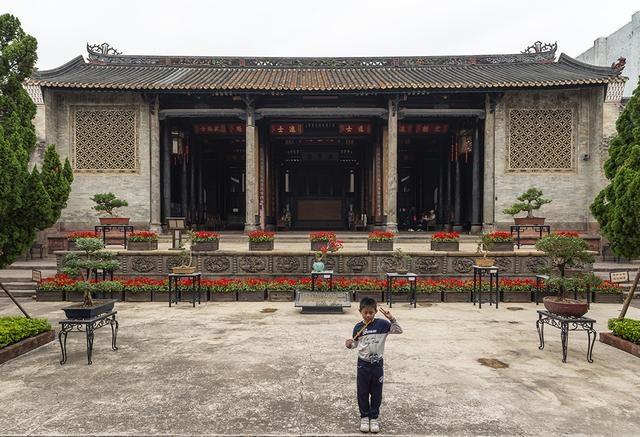
This main hall is called "Xiangxian Hall". The beams, pillars and rafters in the hall are all painted black. There is no ceiling and is directly exposed. The beam is covered with various refreshed plaques, all with gold characters on a red background. Only the plaque "Family of Loyalty and Filial Piety" on the beam of the front gold pillar has gold characters on a blue background.

"Xiangxian" is the name of He Renjian, the fourth ancestor. The plaque of "Da Zong Bo" on the beam of the later gold pillar was written by Zheng Yuncheng, who was equivalent to the governor of Guangdong during the Hongwu period. Da Zong Bo talked about He Qilong, the fifth ancestor of Taichang. The ministers of Rites in various generations after the Tang Dynasty were called Da Zong Bo. The other ones are all wedding invitations for the imperial examination. The plaque next to the big uncle plaque has dense small characters, as well as "Be carried by heaven, the emperor orders..." If you look carefully, you will find that it is the letter of appointment from He Zihai when he was awarded the title of "Governor of Suining County, Pizhou, Fengyang Prefecture" during the Hongwu period. Judging from the layout, this Xiangxian Hall should be a meeting hall at the core of the clan. Although there is no rostrum in front, there is a screen. This is a birthday greeting screen. It was written by Zhang Zhidong, the Minister of War and the Right Governor of Guangdong and Guangxi during the Guangxu period of the Qing Dynasty. Zhang Zhidong served as Minister of War and Governor of Guangdong and Guangxi because of the Sino-French War. During this period, he wrote He Shouping to the He family. Firstly, it was definitely because the He family were local gentry in Guangdong at that time; secondly, it was probably because Zhang Zhidong came to the He family to raise food and pay for resisting the law.

There is another courtyard behind Xiangxian Hall. The main hall is the same as the Xiangxian Hall in front, and it also has five corridors with eaves. There is only one corridor on both sides, so the patio is very small. Based on the ground of Xiangxian Hall in front, there is a three-foot-high platform in the back hall. In this way, when entering the ancestral hall from the outside, there is a one-foot pedestal raised at the stone archway gate; when reaching the front hall, Xiangxian Hall, it is three feet higher; finally, when reaching the back hall, it is three feet higher.
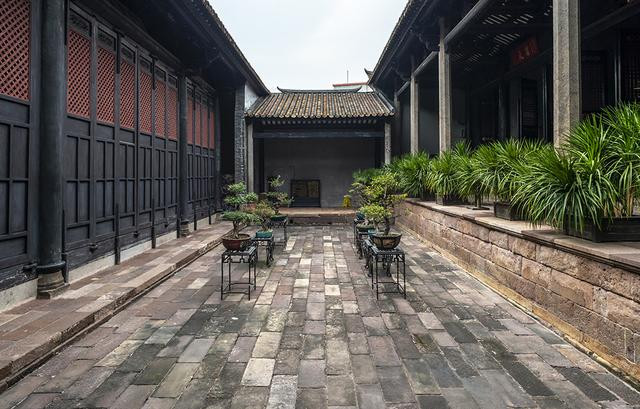
This back hall is the Liugeng Hall. In the center is an altar table with a vase and incense burner placed on it. Behind the altar table is the shrine, which is carved in gold lacquer, and inside are the memorial tablets of the ancestors of the He family in Shawan in order. On the beam of the middle pillar above the shrine is a horizontal plaque titled "Liugentang", which is also inscribed by Chen Xianzhang.

A portrait of Shawan's ancestors hangs under the east wall of Liugentang. The single portrait in the back is "Duke Deming, the fourth ancestor of the He Family", which is He Jian. The portrait of the husband and wife in front is of "Prince He Wei" and his wife, which should be uncertain. The family tree of Shawan He is calculated from the fourth ancestor He Jian, but not even the third ancestor buried with the "sister-in-law tomb", who is He Jian's father. So, who were the ancestors of He He, the fourth ancestor of Shawan, who were the ancestors of He? No exam.

This time, it's right. The front hall, Xiangxian Hall, is the hall where the ancestors enjoyed the worship of future generations; the back hall, Liugentang, is the bedroom hall of the ancestral hall, where the ancestors usually slept. The ancestral tablets are kept in the sleeping hall every day. During the ethnic sacrifice ceremony in the second spring and autumn every year, the ancestral tablets are removed and arranged on the first day. Sacrifices were placed early on the day of the ceremony, and then the chief led all the people to pay homage. After the ceremony, these tablets will be moved back. Xiangdian usually serves as a place where the patriarch holds a plenary session of the core leadership group or standing committee; if necessary, representatives can immediately step into the back hall and swear to their ancestors.
The layout of the ancestral hall is similar, basically with a front hall and a bedroom hall at the back. The Imperial Ancestral Temple in Beijing has an independent tiao hall after the bedroom hall. It was added in the Qing Dynasty and was the bedroom hall of ancestors of various generations who pursued posthumous titles before the founding of the Qing Dynasty.
After seeing these ancient village buildings, my stomach was almost hungry. There is a pond in front of Tianjie in Ho's Grand Ancestral Temple. There is a catering group across the pond. Hungry tourists eat in the group. After eating, they stand under a big tree next to it. The tree is full of bauhinia flowers.

We will definitely do as the Romans do, eat in this group, and go under the bauhinia tree to pick our teeth. After everything is settled, we embark on the road back.
Previous Article:Lingnan feelings, sigh with food and view the sea view, and deeply experience the old times that Guangfu people are most familiar with
Next Article:Accompanied by beautiful scenery and delicious food, have a date with Nansha
